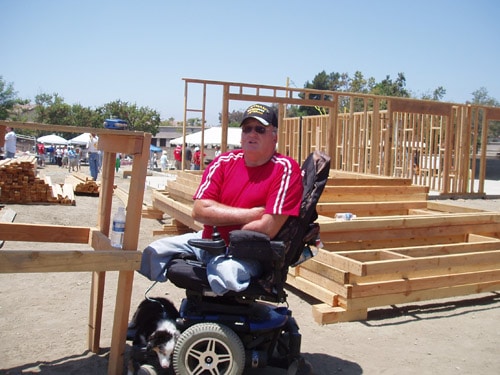Stay safe when using a wheelchair with some tips that can prevent problems and reduce the risks of a nasty fall. Be particularly cognizant of your surroundings to ensure terrain accommodates your chair- and that there are no obstructions in your path.
It can be treacherous to become complacent about wheelchair safety. Be vigilant about staying safe when using a wheelchair and get support for mobility aids and equipment from industry professionals as needed.
Increase your wheelchair safety with these tips:
Practice Different Scenarios
Give yourself time to acclimate to your chair by practicing different scenarios, like going up inclines or transferring in and out of the chair. Lean and bend while in the chair to see how the chair feels and if it remains stable. Remember that going outside the chair’s center of gravity could cause the chair to lean or tip over. Stay safe and practice using the chair with someone nearby.
Furthermore, using the chair builds familiarity which fosters a sense of confidence. The more you practice and use your chair, the easier it will become to get wherever you are going!
Be Careful on Curbs
Curbs require a helping hand to safely navigate. Look instead for a ramp or curb cut that will make traversing far safer. Steps can be dangerous for unassisted wheelchair users; seek an alternate route.
Slow Down
If you go too fast in your chair, you do run the risk of tipping over and sustaining injury. Slick surfaces or an unseen obstacle could send you flying- and could do damage to your wheelchair, too. Be aware of the surface you are traveling on and be prudent with your speed, especially around corners or in unfamiliar territory.
Consider your Terrain
The type of terrain that you take your wheelchair does affect safety. Some chairs are simply not intended for specific weather conditions, environments, and uses. Most wheelchairs do not function well on sandy surfaces, such as the beach. Keep an eye out for patches of sand on sidewalks or roadways, too, as these can prove problematic for many wheelchairs.
Also, uneven or inclined surfaces can cause a wheelchair to lean, tip, and even fall over.
Avoid water, like puddles and slippery surfaces, when possible. When the chair becomes wet, it is more prone to sliding around or falling over. Prevent these disasters by going around water whenever you can and by going slow during inclement weather.
Outdoor ramps are notorious for being slick and treacherous, especially when they are permanent ramps made from wood. Take a closer look at new or unfamiliar ramps before you take your wheelchair onto its surface. Is it uneven? Are there holes on the ramp? How slick does it look? Make sure it looks safe before you choose to use the ramp. If the ramp is unsafe, ask about another entry like a wheelchair elevator to gain access.
Reduce the Risk of a fall
Reduce your risk of a fall when using your wheelchair and avoid leaning forward when in the chair. Also, be careful when reaching for items that might be out of reach. This can cause the chair to tip and fall. Always lock your brakes before getting in or out of the chair to help reduce the chances of a fall. Keep in mind that the footrests can trip you- or others- up during transfers when they are not adjusted and moved out of place.
Take Care of Your Equipment
Have your chair inspected and serviced each year. Talk to your retailer to make sure that you have service and support in place for longevity of your chair.
Make maintaining the wheelchair a priority. Keep your battery charged for motorized chairs and seek out help at the first sign of an issue. The condition of your chair is key in keeping yourself safe.
More Safety Strategies
- Never force a wheelchair up or down stairs, steps, or slopes.
- Turn off your wheelchair before and keep the brakes locked when transferring in or out of the chair.
- Make sure you are seen with lights, flags, or other eye-catching features, when possible.
- Before using, make sure to adjust and lift the arm and footrests.
- Add reflectors and lights to your wheelchair to be seen after dark.
- Maintain and service your wheelchair as recommended by the manufacturer to ensure it is working properly.
- Try to avoid trips out in your wheelchair when it is raining. The terrain can become slick, and some motorized chairs can malfunction when wet. Also, it could be difficult for your chair to gain traction in rainy conditions.
- Heavy bags or loads on the back of a wheelchair can cause it to tip.
Considering a new wheelchair? Visit and talk with the industry professionals at Pacific Mobility, and use these tips to increase wheelchair safety!
President, Husband, Father, Grandfather Graduate of UC Davis- Bio Sci Major- Go Aggies! Jeff has extensive experience in all of Pacific Mobility’s products and services, and specializes in accessibility products as well as stairlifts, ceiling lifts and custom wheel chairs. His hobbies include spending time with family, gardening, mountain biking, exercising and off road motorcycle riding.
24 years as Owner/President of Pacific Mobility Center – selling, installing, and servicing stairlifts, porch lifts, ceiling lifts, pool lifts, handicap ramping, specialty wheelchairs, scooters, power wheel chairs, and other power mobility devices
Certified Environmental Access Consultant since 2008
Licensed General Contractor since 1998
Certified Aging in Place Specialist since 2016
Board Member for Home Access Professionals
Member of Association of Members of the Accessibility Equipment Industry (AEMA)




